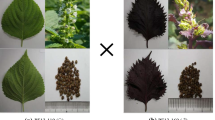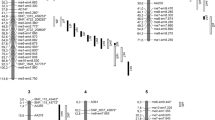Abstract
Based on double pseudo-testcross theory, a population of 79 F1 clones, which was derived from a crossing of two tea cultivars using a Japanese tea cultivar “Fushun” (Camellia sinensis) as female parent and a Korean tea cultivar “Kemsull” (C. sinensis) as male parent, was applied to construct a genetic linkage map with different molecular markers. Previously, 143 random amplified polymorphism DNA (RAPD) markers and 11 simple sequence repeat (SSR) loci developed from 41 decamer random primers and 60 published SSR primer pairs, respectively, were used into our mapping analysis. In the study of amplified fragment length polymorphism (AFLP), 2439 bands were generated from 27 primer combinations with an average number of 90.3 bands for each, of which 495 (20.3%) were polymorphic. The majority of those polymorphic markers segregated in accordance with Mendelian segregation ratios at p < 0.01 for 400 (80.8%) or at p < 0.05 for 382 (77.2%), of which 136 (34.0%) or 131 (34.3%) were at 3:1 segregation ratios and 264 (66.0%) or 251 (65.7%) were at 1:1 segregation ratios at p < 0.01 and p < 0.05, respectively. For developing more SSR markers, the transcriptome sequences of flowers and leaves of two parents were obtained using high throughput RNA sequencing and compared. Afterwards, 1800 potential polymorphic SSR markers were successfully developed and 296 of them were selected and experimentally validated with a subset of tea plants (including two parents and six F1 offspring), from which 75 (25.3%) were repeatably amplified and polymorphic between two parents. From that, 29 (38.7%) newly mined SSR markers were heterozygous in “Fushun” and/or “Kemsull” and showed segregant genotypes in F1 seedlings and were adoptable by JoinMap 4.0. Totally, 678 markers including 143 RAPDs, 11 public SSRs, 495 AFLPs, and 29 newly mined SSRs were conjointly used to construct a combined linkage map for tea plant. The new genetic map located 79 RAPDs, 5 public SSRs, 214 AFLPs, and 11 new SSRs developed from RNA seq technique and covered 1441.6 cM with an average distance of 4.7 cM between two adjacent markers. This map will lay a foundation for qualitative or quantitative trait loci (QTLs) analysis of important agronomic traits for tea plant in the future study.




Similar content being viewed by others
References
Cervera MT, Storme V, Ivens B et al (2001) Dense genetic linkage maps of three Populus species (Populus deltoides, P. Nigra and P. Trichocarpa) based on AFLP and microsatellite markers. Genetics 158:787–809
Chang YL, Ou EN, Min SL et al (2015) Preliminary linkage mapping of tea plants with RAPD and SSR markers. J Korean Tea Soc 4:89–94
Chen L, Zeno A, Chen ZM (2012) Global tea breeding: achievements, challenges and perspectives. Zhengjiang University Press, Hangzhou
Cox MP, Peterson DA, Biggs PJ (2010) SolexaQA: at-a-glance quality assessment of Illumina second-generation sequencing data. BMC Bioinform 11:485
Doerge RW (2002) Mapping and analysis of quantitative trait loci in experimental populations. Nat Rev Genet 3:43–52
Grattapaglia D, Sederoff R (1994) Genetic linkage maps of Eucalyptus grandis and Eucalyptus urophylla using a pseudo-testcross: mapping strategy and RAPD markers. Genetics 137:1121–1137
Hackett CA, Wachira FN, Paul S (2000) Construction of a genetic linkage map for Camellia sinensis (tea). Heredity 85(4):346–355
Hu CY, Lee TC, Tsai HT (2013) Construction of an integrated genetic map based on maternal and paternal lineages of tea (Camellia sinensis). Euphytica 191:141–152
Huang JA, Li JX, Huang YH et al (2005) Construction of AFLP molecular markers linkage map in tea plant. J Tea Sci 25(1):7–15
Kenis K, Keulemans J (2005) Genetic linkage maps of two apple cultivars (Malus domestica Borkh.) based on AFLP and microsatellite markers. Mol Breed 15:205–219
Li H, Durbin R (2009) Fast and accurate short read alignment with Burrows-Wheeler transform. Bioinformatics 25:1754–1760
Lorieux M, Ndjiondjop MN, Ghesquiere A (2000) A first interspecific Oryza sativa × Oryza glaberrima microsatellite based genetic linkage map. Theor Appl Genet 100:593–601
Luro FL, Costantino G, Terol J et al (2008) Transferability of the EST-SSRs developed on Nules clementine (Citrus clementina Hort ex Tan) to other Citrus species and their effectiveness for genetic mapping. BMC Genomics 9:287
Ma JQ, Zhou YH, Ma CL et al (2010) Identification and characterization of 74 novel polymorphic EST-SSR markers in the tea plant, Camellia sinensis (Theaceae). Am J Bot 97:e153–156
Ma JQ, Yao MZ, Ma CL (2014) Construction of a SSR-based genetic map and identification of QTLs for catechins content in tea plant (Camellia sinensis). PLoS ONE 9(3):e93131
Ma JQ, Huang L, Ma CL et al (2015) Large-scale SNP discovery and genotyping for constructing a high-density genetic map of tea plant using specific-locus amplified fragment sequencing (SLAF-seq). PLoS ONE 10(6):e0128798
Ota S, Tanaka J (1999) RAPD-based linkage mapping using F1 segregating population derived from crossings between tea cultivar ‘Sayamakaori’ and strain ‘Kana-Ck17’. Breed Res 1:16
Schulz MH, Zerbino DR, Vingron M et al (2012) Oases: robust de novo RNA-seq assembly across the dynamic range of expression levels. Bioinformatics 28(8):1086–1092
Shiv SK, Alexander Z, Park YG (2000) Evaluation of the genetic diversity among elite tea (Camellia sinensis var. sinensis) accessions using RAPD markers. Euphytica 115:7–16
Stam P (1993) Construction of integrated genetic linkage maps by means of a new computer package: JoinMap. Plant J 3:739–744
Tan LQ, Wang LY, Wei K et al (2013) Floral transcriptome sequencing for SSR marker development and linkage map construction in the tea plant (Camellia sinensis). PLoS ONE 8(11):e81611
Tanaka J (1996) The possibility of using RAPD analysis to create genetic map of tea. Tea Res J 84:44–45
Taniguchi F, Furukawa K, Ota-Metoku S et al (2012) Construction of a high-density reference linkage map of tea (Camellia sinensis). Breeding Sci 62:263–273
Tavassolian I, Rabiei G, Gregory D et al (2010) Construction of an almond linkage map in an Australian population Nonpareil × Lauranne. BMC Genomics 11:551
Untergrasser A, Cutcutache I, Koressaar T et al (2012) Primer3—new capabilities and interfaces. Nucleic Acids Res 40(15):e115
Van Ooijen JW (2006) JoinMap® 4. Software for the calculation of genetic linkage maps in experimental populations, Kyazma BV
Vos P, Hogers R, Bleeker M et al (1995) AFLP: a new technique for DNA fingerprinting. Nucleic Acids Res 23(21):4407–4414
Yin TM, Difazio SP, Gunter LE et al (2004) Large-scale heterospecific segregation distortion in Populus revealed by a dense genetic map. Theor Appl Gene 109:451–463
Zalapa JE, Cuevas H, Zhu H et al (2012) Using next-generation sequencing approaches to isolate simple sequence repeat (SSR) loci in plant sciences. Am J Bot 99(2):193–208
Zerbino DR, Birney E (2008) Velvet: algorithms for de novo short read assembly using de Bruijn graphs. Genome Res 8(5):821–829
Zhang SM (2009) Applications of AFLP and SSR technologies in genetic diversity analysis of Chinese bayberry. Dissertation, Zhejiang University
Zhang H, Wei L, Miao HM et al (2012) Development and validation of genic-SSR markers in sesame by RNA-seq. BMC Genomics 13:316
Acknowledgements
This work was carried out with the support of the “Cooperative Research Program for Agricultural Science & Technology Development” (Project No. PJ 011964) Rural Development Administration, Republic of Korea.
Author information
Authors and Affiliations
Corresponding author
Ethics declarations
Conflicts of interest
The authors declare no conflicts of interest associated with this work.
Electronic supplementary material
Below is the link to the electronic supplementary material.
Rights and permissions
About this article
Cite this article
Chang, Y., Oh, E.U., Lee, M.S. et al. Construction of a genetic linkage map based on RAPD, AFLP, and SSR markers for tea plant (Camellia sinensis). Euphytica 213, 190 (2017). https://doi.org/10.1007/s10681-017-1979-0
Received:
Accepted:
Published:
DOI: https://doi.org/10.1007/s10681-017-1979-0




